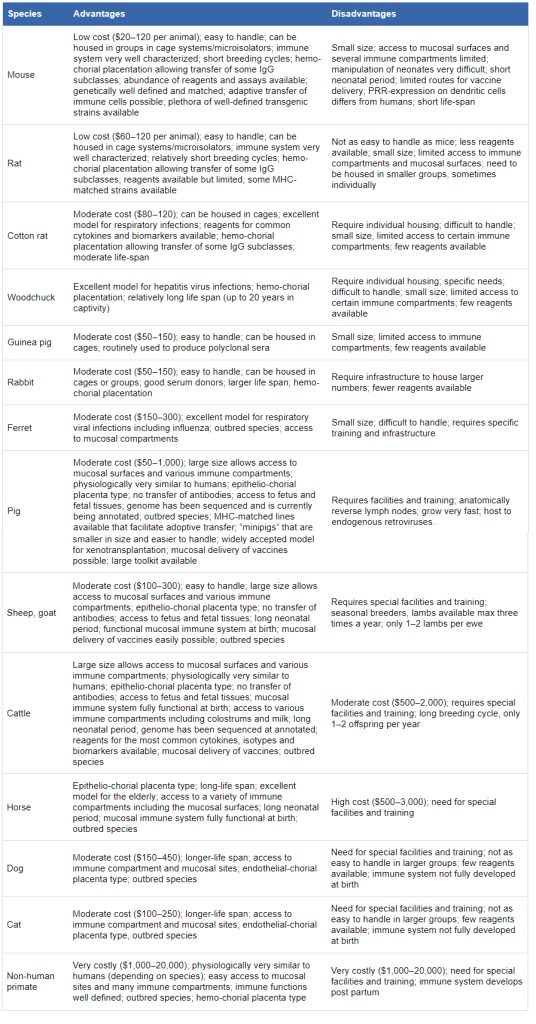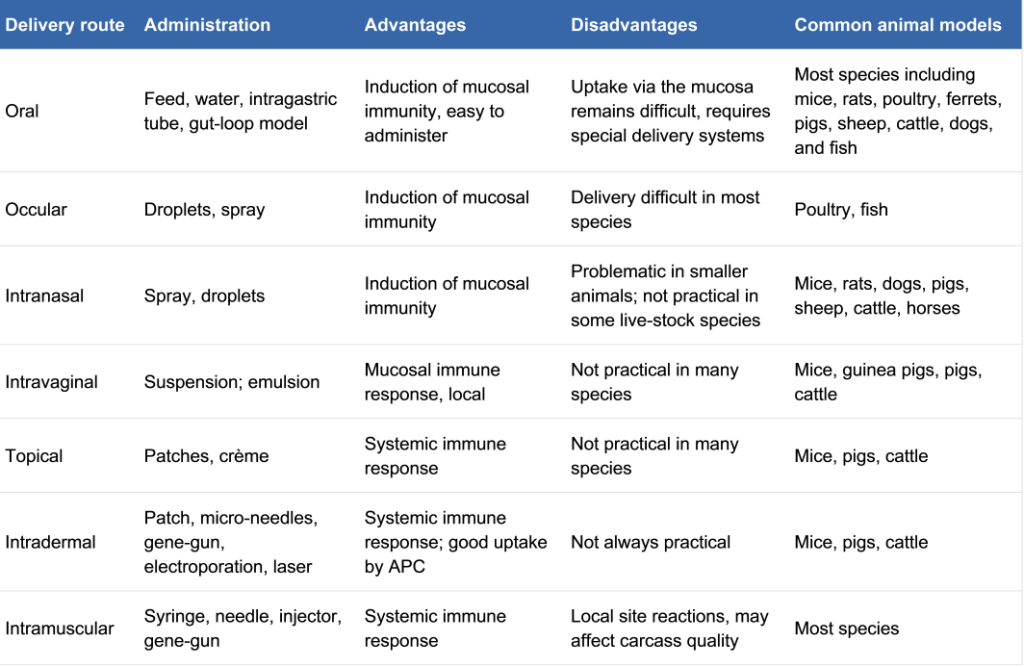When Jenner discovered the smallpox virus in 1798, scientists realized that animal models could be a powerful tool for studying human infectious diseases. Animal models are commonly used to evaluate various immunological parameters: humoral and cell-mediated immunity, onset and duration of immunity, systemic and mucosal immunity, prevention of infection and reduction of disease spread, etc. There are a wide variety of animal models in nature, ranging from very small insects to very large livestock. The range of animal models is wide, including genetically modified and cloned animals, outbred animals, surgical animal models, humanized animal models, newborn and old animals, and wild animals. They can be used to simulate single and mixed infections, chronic diseases and autoimmune diseases, and they can also be used to analyze herd immunity after vaccination, the spread of infectious diseases between infected and uninfected animals, and to study the transfer of passive immunity via placenta, colostrum and milk. Therefore, selecting the appropriate animal model is the key to developing a more effective vaccine.
Animal Models for Vaccine Development
Using animal models to test the effectiveness of vaccines is one of the key steps in vaccine development and is often a key point in the long process of vaccine development and registration. Hundreds of different animal models can be used to evaluate multiple aspects of the immune response. Although many countries are promoting scientific experiments with alternative animals as much as possible and minimizing the number of animals used in scientific research, since there are currently no other feasible methods to evaluate or test the immune response after vaccination, the use of animals in experimental research in vaccine development remains the key. Choosing the most suitable animal model for this purpose is the key to the success of the experiment and to reducing the use of animals and research funding. Most vaccines have been evaluated in some way on small rodents, mostly mice. The advantages of using mice are low cost, easy manipulation, and specific genetic background and immune functions. In addition, a large number of immune components in mice can be used to explain the specific immune response caused by the vaccine. Because other species have much less immune components, this limits the level of detail in immune response analysis. However, large animal species such as pigs, cattle and sheep also have advantages, as they are closer to humans in terms of physiological functions and immune characteristics, and they are often hosts of the same or closely related pathogens. In addition, large animal species mainly reproduce outbreeding, and the normal distribution of vaccine responders and non-responders can be fully understood, which is very important for vaccine development. Animal models may be described in a number of ways: induced (experimental), spontaneous (natural), genetically modified, negative, orphan, and surrogate. These models vary widely in scope of application, cost, and their requirements for special infrastructure. The following are the advantages and disadvantages of commonly used animal models in vaccine development (Table 1):
Table 1. The advantages and disadvantages of conventional animal models in development of vaccine.
Screening of Animal Models
During the development of vaccines, not only should appropriate animal models be selected based on the delivery route of the vaccine being developed, but also the ethical issues when using animal models should be considered. Therefore, before using animal models, various factors need to be comprehensively considered to select the most suitable animal model to solve specific problems during the experimental process. For the development of a vaccine, there may be more than one animal model suitable for it. The following table summarizes the advantages and disadvantages of common vaccine delivery routes and the corresponding animal models (Table 2).
Table 2. The vaccine delivery routes and related animal models.
All in all, animal models are crucial and indispensable for vaccine development. It is essential when determining the quality and quantity of the immune response of a vaccinator, evaluating the safety and toxicity of the vaccine formulation, determining the effectiveness of the vaccine in providing protection against attacking infections, and evaluating the likelihood that the vaccine will prevent the transmission of disease in a specific population. At the same time, the selection of the most suitable animal model should be based on the special needs of the research project, and should not be influenced by factors such as price and difficulty of handling. In addition, in the long run, selecting the right animal model when developing new vaccines can save a lot of money, time and valuable resources.
Creative Diagnostics provides a large number of infectious animal models and a large library of viral pathogens for the development of new vaccines and antiviral drugs. These models include:
| Animal Models | Target | Animal Type |
| HIV Infection Rhesus Monkey Model | SIVmac251, SIVmac239, SHIVSF162p3, SHIV-1157ipd3N4, RT-SHIV/TC, SHIV KU-1, SHIV-KB9, SHIVchn19p4 | Rhesus Monkey |
| Influenza A Virus Mouse Model | H9N2, H1N1, Pdm H1N1, H3N2 | Mouse |
| Coronavirus Animal Model | SARS-CoV-2 | Rhesus Monkey, Mouse, Hamster |
| MERS-CoV Animal Model | MERS-CoV | Rhesus Monkey, Mouse |
| Coxsackie Virus Mouse Model | CV A16, CV B3 | Mouse |
| Enterovirus Mouse Model | EV 71, EV71-Adapted Strain MP-10 | Mouse |
| ZIKA Virus Animal Model | ZIKA AG129 | Mouse, Rhesus Monkey |
| Dengue Virus Mouse Model | DENV AG129, DENV 2 | Mouse |
| HSV Animal Model | HSV | Mouse, Rabbit, Guinea Pig |
| Respiratory Syncytial Virus Animal Model | RSV | Mouse, Cotton Rat |
| Hepatitis Virus Animal Model | HBV, DHBV, WHV | Mouse, Pekin Duck, Campbell Duck, Shelduck, Woodchucks |
In addition, we provide well-designed analytical services that allow researchers to obtain well-researched animal models of viral infection. These models provide a multi-faceted perspective on infection dynamics, covering a range of parameters such as clinical symptoms, virus proliferation rates, clinical pathological characteristics, and cellular and humoral immune responses. Working with us ensures that a single scientific study for each project is supported by carefully designed methods, thereby promoting breakthrough discoveries in the pathogenesis and treatment of the virus.
Reference
Kiros, Tadele G., et al. The importance of animal models in the development of vaccines. Innovation in Vaccinology: from design, through to delivery and testing. 2012: 251-264.


